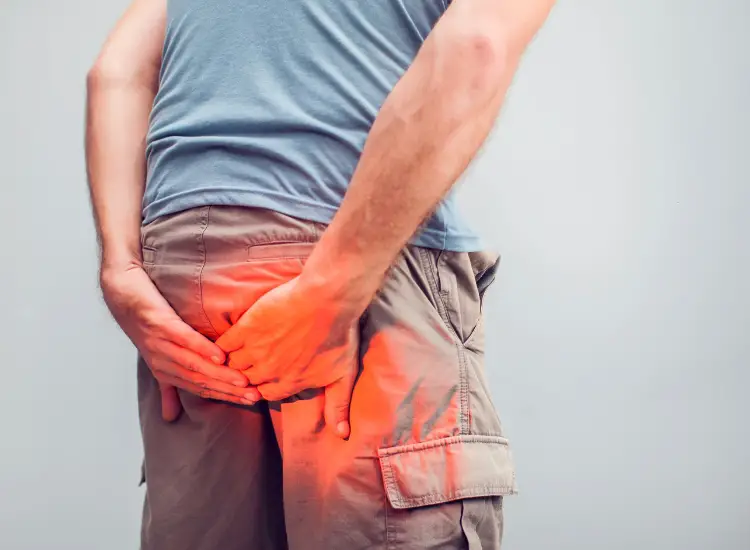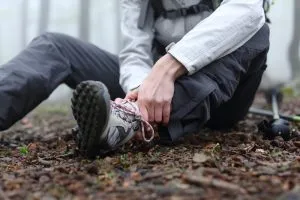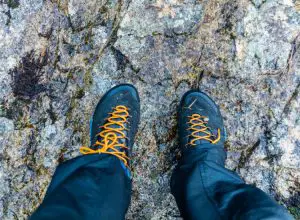How To Prevent Butt Chafing While Hiking: The Ultimate Guide

Hey. How’s your butt?
Are you tired of dealing with painful butt chafing while hiking? Well, me too! So, in this article, we’ll explore some practical tips and tricks to help you prevent butt chafing and make your hiking experience much more enjoyable.
Butt chafing is an unfortunate side effect of hiking, especially when you’re out on the trails for an extended period of time. It can leave you feeling sore, uncomfortable, and even ruin your entire outdoor adventure. So, let’s dive in and discover some effective methods to keep your derriere happy and chafe-free while exploring the great outdoors!
Quick Links
What Causes Butt Chafing While Hiking?
Butt chafing is actually a common issue that many hikers experience during long hikes or intense physical activity. It occurs when the skin on the buttocks rubs against clothing or other surfaces, causing irritation and discomfort. Several factors can contribute to butt chafing while hiking.
Friction: Friction is the primary cause of butt chafing during hiking. When the skin repeatedly rubs against clothing, backpacks, or seats, it can lead to irritation and abrasion. Moisture from sweat can exacerbate the friction, making the chafing more severe.
Poor-Fitting Clothing: Wearing ill-fitting or non-breathable clothing can increase the risk of butt chafing. Tight clothing can create more friction, while clothing made from non-breathable materials can trap moisture, leading to increased irritation.
Lack of Lubrication: Insufficient lubrication between the skin and clothing can contribute to butt chafing. Sweat alone may not provide enough lubrication to reduce friction, especially during prolonged or intense activity. Applying appropriate lubricants or anti-chafing products can help reduce the risk of chafing.
Long-Distance Walking or Hiking: Engaging in long-distance hikes or walking for extended periods without breaks can increase the likelihood of butt chafing. The constant movement and friction can gradually wear down the skin and cause chafing.
Not Using Moisture-Wicking Material: Moisture-wicking materials can help manage sweat and moisture, reducing the chances of chafing. Choosing clothing made from these materials can help keep the buttocks area dry and minimize friction.
Preexisting Skin Conditions: Individuals with preexisting skin conditions, such as eczema or sensitive skin, may be more prone to butt chafing while hiking. These conditions can make the skin more vulnerable to irritation and damage from friction.
To prevent butt chafing while hiking, it is essential to take some precautionary measures. These include wearing moisture-wicking and breathable clothing, applying lubricants or anti-chafing products to susceptible areas, taking regular breaks to rest and dry off, and keeping the buttocks area clean and dry. Additionally, choosing well-fitting gear, such as backpacks and hiking pants, can reduce the risk of friction and irritation.
Choosing the Right Clothing to Prevent Butt Chafing
Material MATTERS!!
When it comes to preventing butt chafing, choosing the right material for your clothing can make a huuge difference. Go for breathable fabrics that wick away moisture, such as cotton or moisture-wicking synthetic blends. Avoid fabrics that can trap moisture, like nylon or polyester, as they can contribute to friction and irritation.
Fit and Fabric Weight
The fit and fabric weight of your clothing can also impact the likelihood of butt chafing. Avoid tight-fitting garments that can rub against your skin and cause friction. Instead, opt for looser, lightweight clothing that allows for air circulation and reduces the risk of irritation.
Seam Placement and Design
Pay attention to the seam placement and design of your clothing, particularly in areas prone to friction. Look for flat seams or garments with minimal seams that reduce the potential for rubbing. Seamless underwear or shorts can be particularly beneficial in preventing chafing in the butt area.
Avoid Rough or Embellished Fabrics
Fabrics with rough textures or embellishments, such as sequins or beads, can increase friction and irritation. Choose smooth, soft fabrics without any added embellishments to minimize the risk of butt chafing.
Consider Moisture-Wicking Underwear
Consider wearing moisture-wicking underwear specifically designed to keep you dry and prevent chafing. These undergarments are made from synthetic materials that draw sweat away from your skin, reducing moisture and friction.
By paying attention to the material, fit, seam placement, and design of your clothing, you can significantly reduce the risk of butt chafing and enjoy more comfortable days.
Using Lubricants to Prevent Butt Chafing
Yes. That’s right. I’m telling you to lube up your butt. Using lubricants can help reduce friction, prevent chafing, and provide relief from discomfort. Here are some important tips and considerations for using lubricants to prevent butt chafing:
Selecting the Right Lubricant
When choosing a lubricant for butt chafing prevention, it is important to select a product that is suitable for sensitive skin and safe for use in the intimate area. Look for lubricants that are water-based, hypoallergenic, and free of fragrances or irritants. Avoid using oil-based lubricants, as they can weaken latex condoms and increase the risk of infections.
Proper Application
Apply a generous amount of lubricant to the areas prone to chafing, such as the buttocks or inner thighs. Make sure to cover the entire area with a thin, even layer of lubricant. It is recommended to reapply as needed, especially during activities that involve prolonged sitting, walking, or sweating.
Considerations for Different Activities
Depending on the specific activity or situation, different lubricants may be more suitable. For daily activities or sports, a long-lasting lubricant that provides a barrier against friction may be preferred. For intimate activities, consider using a lubricant specifically designed for sexual purposes, as they are formulated to enhance comfort and pleasure.
Other Prevention Methods
While lubricants can be effective in preventing butt chafing, it is also important to consider other preventive measures. These include wearing breathable and moisture-wicking underwear, avoiding tight-fitting clothing, maintaining good hygiene, and keeping the affected area clean and dry.
By incorporating lubricants into your routine and following these tips, you can effectively prevent butt chafing and enjoy a comfortable and irritation-free experience.
Proper Hygiene Practices to Prevent Butt Chafing
Choosing the Right Underwear
One of the key factors in preventing butt chafing is choosing the right underwear. Go for underwear made from moisture-wicking and breathable fabrics, such as cotton or moisture-wicking synthetic materials. Avoid tight or restrictive underwear that can increase friction and irritation.
Keep the Area Clean and Dry
Maintaining good hygiene is crucial in preventing butt chafing. Clean the area with mild soap and water, and make sure to thoroughly dry the butt after bathing or using the bathroom. Moisture can increase the chances of friction and irritation, so keeping the area dry is essential.
Apply a Barrier Cream or Powder
Using a barrier cream or powder can help reduce friction and irritation on the butt. Look for products specifically formulated to protect against chafing, such as creams containing zinc oxide or powders with cornstarch. Apply a thin layer of the cream or powder to the affected area before any activities that may cause friction, such as exercise or prolonged sitting.
Avoiding Irritating Fabrics
Certain fabrics can irritate the skin and contribute to butt chafing. Avoid wearing rough or scratchy materials, such as wool, directly against the skin. Choose soft, breathable fabrics that allow for airflow and reduce friction.
Take Breaks from Prolonged Sitting or Strenuous Physical Activity
If you’re sitting for long periods or engaging in strenuous physical activity, take regular breaks to relieve pressure and reduce the risk of butt chafing. Stand up, walk around, and give the area a chance to rest and recover.
Stay Hydrated
Drinking plenty of water can help maintain healthy skin and reduce the risk of dryness and irritation. Proper hydration can also help prevent excessive sweating, which can contribute to chafing. Aim to drink at least 8 glasses of water per day.
Wear Loose-Fitting Clothing
Tight clothing, especially in the buttocks area, can increase friction and irritation. Go for loose-fitting clothing that allows for comfortable movement and reduces the chances of chafing. Avoid wearing clothing made from rough or abrasive materials.
By following these proper hygiene practices, you can effectively prevent butt chafing and keep the buttocks area comfortable and healthy. If the problem persists or becomes severe, it is advisable to consult a healthcare professional for further evaluation and treatment.
Avoiding Excessive Moisture to Prevent Butt Chafing
Understanding Butt Chafing
Butt chafing, also known as intertrigo, is a common skin condition that occurs when the skin in the buttocks area becomes irritated, red, and painful due to friction and moisture. It often occurs in individuals who sweat excessively or those who remain in a wet or moist environment for prolonged periods.
Tips for Preventing Butt Chafing
There are several measures you can take to prevent butt chafing and keep your skin comfortable and healthy. Consider the following tips:
- Keep the area clean and dry: After showering or bathing, make sure to thoroughly dry the buttocks area. Moisture can contribute to chafing, so it’s important to keep the area as dry as possible.
- Wear breathable underwear: Choose underwear made of breathable materials such as cotton. Avoid synthetic fabrics that can trap moisture and increase friction.
- Choose loose-fitting clothing: Tight clothing can increase friction and exacerbate chafing. Go for loose-fitting pants and shorts to minimize irritation.
- Apply a barrier cream: Using a protective barrier cream, such as petroleum jelly or zinc oxide, can create a barrier between the skin and moisture, reducing friction and irritation.
- Use powder or cornstarch: Applying a talcum powder or cornstarch can help absorb moisture and keep the buttocks area dry.
- Avoid prolonged sitting or sweating: Sitting for extended periods can create a moist environment that promotes chafing. If possible, take breaks and move around to minimize friction. Additionally, avoiding excessive sweating through regular showering and wearing breathable clothing can help prevent chafing.
By following these tips, you can reduce the risk of butt chafing and maintain comfortable, healthy skin in the buttocks area. If chafing persists or becomes severe, it is advisable to consult a healthcare professional for further evaluation and guidance.
Preventing Butt Chafing on Different Types of Hiking Terrains
Importance of Proper Gear and Clothing
To prevent butt chafing while hiking, it is crucial to wear the right gear and clothing. Choose moisture-wicking and breathable fabrics that reduce friction and keep the skin dry. Avoid cotton as it retains moisture, which can increase the likelihood of chafing. Additionally, consider wearing compression shorts or underwear with a seamless design to minimize friction and provide support.
Proper Hygiene and Preparation
Maintaining good hygiene is essential in preventing butt chafing. Before hiking, make sure to clean and dry the buttocks area thoroughly. Apply an anti-chafing cream, powder, or petroleum jelly to reduce friction and create a protective barrier. Consider packing extra supplies for longer hikes to reapply as needed and bring wet wipes for convenient cleaning during breaks.
Know the Terrain and Adjust Hiking Technique
Understanding the type of terrain you will be hiking on can help prevent butt chafing. Different terrains, such as rocky trails or sandy beaches, can increase the risk of friction and irritation. Modify your hiking technique to reduce strain on the buttocks area. Taking shorter strides and varying your walking pattern can distribute pressure more evenly and minimize chafing.
Stay Hydrated and Take Breaks
Hydration plays a crucial role in preventing butt chafing. Proper hydration helps maintain skin elasticity and reduces the likelihood of dryness or irritation. Drink plenty of water during your hike to keep the skin hydrated. Taking regular breaks to rest and reapply any anti-chafing products can also provide relief and prevent further irritation.
Listen to Your Body and Take Action
Lastly, pay attention to any discomfort or early signs of chafing. If you start to feel irritation or notice redness, take immediate action to prevent further damage. Reapply the necessary creams or powders, adjust your clothing, or consider using additional padding or cushioning in the affected area. Ignoring early signs can lead to more severe chafing and discomfort.
Recognizing and Treating Butt Chafing
So.. now you know all there is to butt chafing. Recognizing the symptoms of butt chafing and taking appropriate measures to treat and prevent it can help alleviate discomfort and promote healing. So, let’s get into it.
Identifying the Signs of Butt Chafing
Butt chafing is characterized by various symptoms that may vary in severity. Common signs of butt chafing include:
- Redness and irritation: The affected skin may appear red, inflamed, and feel irritated to the touch.
- Rash or blisters: Butt chafing can lead to the development of a rash, blisters, or small sores in the affected area.
- Burning or stinging sensation: Chafed skin may cause a burning or stinging sensation, especially when touched or exposed to sweat or moisture.
- Itching: Butt chafing can be accompanied by itching, which may worsen if the affected area remains moist or is repeatedly irritated.
- Pain or discomfort: Chafed skin can be painful, especially during movement or when pressure is applied.
Treating Butt Chafing
Treating butt chafing involves alleviating symptoms, promoting healing, and preventing further irritation. Here are some effective strategies to help treat butt chafing:
- Cleanse the affected area: Gently wash the buttocks with a mild, fragrance-free cleanser and warm water. Pat the area dry with a soft towel, avoiding harsh rubbing.
- Apply a protective barrier: Apply a thin layer of a barrier cream or ointment, such as petroleum jelly or zinc oxide, to create a protective barrier between the skin folds and clothing.
- Avoid tight or abrasive clothing: Choose loose-fitting, breathable clothing made of natural fabrics to minimize friction and irritation.
- Keep the area dry: Moisture can worsen butt chafing, so ensure the affected area is kept clean and dry. Consider using talcum powder or moisture-absorbing pads to help keep the buttocks area dry.
- Take breaks from prolonged sitting: If you spend long periods sitting, take regular breaks to allow your skin to breathe and reduce friction.
- Avoid excessive sweating: Excessive sweating can exacerbate butt chafing, so try to stay cool and dry, especially during physical activity or in hot weather.
- Use over-the-counter creams or ointments: Consider applying over-the-counter hydrocortisone creams or anti-fungal ointments to soothe inflammation and prevent infection.
- Consult a healthcare professional: If butt chafing persists, worsens, or is accompanied by severe pain, swelling, or signs of infection, it is advisable to seek medical advice for further evaluation and treatment.
By promptly recognizing and treating butt chafing, you can alleviate discomfort and promote healing. It is important to practice good hygiene, keep the affected area clean and dry, and take preventive measures to minimize friction and irritation. If symptoms persist or worsen, consult a healthcare professional for appropriate diagnosis and treatment.
Conclusion
Butt chafing is a common issue that many hikers experience during long hikes or intense physical activity. It is caused by the repeated rubbing of the skin on the buttocks against clothing or other surfaces, resulting in irritation and discomfort.
To prevent butt chafing while hiking, it is important to take precautionary measures such as wearing moisture-wicking and breathable clothing, applying lubricants or anti-chafing products, taking regular breaks to rest and dry off, and maintaining proper hygiene.
By following these tips, hikers can enjoy more comfortable and irritation-free hikes. However, if butt chafing persists or becomes severe, it is recommended to seek guidance from a healthcare professional for further evaluation and treatment.







